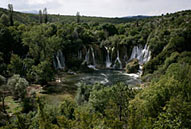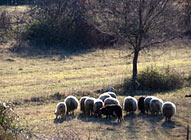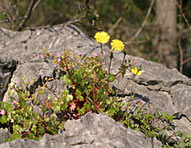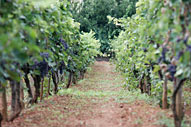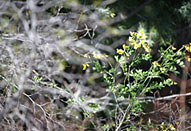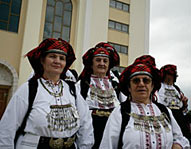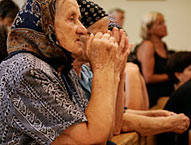
REGIONAL REFERENCES AND THE POPULATION
I. GEOGRAPHICAL SITUATION, CLIMATE, HYDROGRAPHICAL CONDITIONS AND VEGETATION
1.1. Geographical Situation of Herzegovina
The Parish of Medjugorje is situated in the southern part of Herzegovina in the present-day state of Bosnia and Herzegovina. In order for the reader to have a complete picture of the situation, climate, irrigation and vegetation of Medjugorje, it is essential to have a better look at its surrounding areas.
Herzegovina is situated between two regions: a mountainous region to the north and a coastal region to the south. The mountainous wall to the north holds back the circulation of atmospheric masses from the Mediterranean, creating favourable climatic conditions for various vegetal cultivations in the area of Herzegovina.
Herzegovina covers an area of 9,948 square kilometres. It is bordered to the east by Montenegro, to the west by Bosnia, to the south and southeast by southern Croatia and in one area forms part of the Adriatic coast. The main cultural and administrational centre is Mostar.
1.2. Climatic conditions
The nearby sea, relief, and height above sea level influence the climate of Herzegovina.
Medjugorje is situated in the part of Herzegovina where the Mediterranean climate, with its gentle winters and warm summers, is predominant. It is characterised by rainfall in the colder period of the year.
During winter, the Adriatic Sea gives off the heat accumulated during the summer period, easing winter atmospheric temperatures.
In July and August, summer temperatures reach their maximum.
Maximum precipitation takes place in the autumn, though rainfall can also be felt in the spring. However, the greatest quantities fall in November and December.
Regarding wind, north and northeasterly winds are predominant. Locally, they are referred to as "northerly" or "Bura". Winter is at its coldest when this characteristically dry wind blows every second day.
Herzegovina has another recurring wind called "Jugo". This wind blows directly from the Adriatic Sea, most often during the autumn and spring. It is saturated with humidity and in the autumn brings rainfall in large quantities. It is considerable in strength and blows for a few days, after which the showers then stop.
On the basis of climatic evidence found in meteorological annals, we can conclude that Herzegovina is influenced by Mediterranean, continental, and mountain climates. And, in the area of southern Herzegovina where Medjugorje is situated, a Mediterranean climate is predominant.
1.3. Hydrographical Conditions
Herzegovina is a rugged country in which limy layers originating in the Triassic, Jurassic, and Cretaceous ages extend for tens of metres. These layers spring up in spots, are sometimes crushed, or are in the form of large masses. Water follows these rifts, disappears from the surface for a while, creates receptacles underground, or pours underground and crops up later on the surface as a whole river. From these sources the Herzegovinian Rivers - Buna, Tihaljina, Radobolja, Trebisnica, Vriostica, Bregava, Rama, Buka, Krupica etc. - well up. Some of these rivers, after a short flow on the surface, disappear again underground, and after a few kilometres, spring up on the surface again and receive another name.
The copious autumn rains, which fall in the area of Herzegovina, create streams. These make the rivers swell and flood, and the Karst expanses become lakes. The area of southern Herzegovina is more sparse regarding mountain springs. However, those water springs which it does possess present a real attraction, being more abundant than those of the mountains.
The waterways of Herzegovina are very attractive: Some, for the nature-lovers, some for the canoers, some for the fisherman, and others for those seeking a place to bathe, rest and refresh themselves.
1.4. Vegetation
Just as the area of Herzegovina stretches from the coast to high mountain-land, so too the belts of woodland correspond to the different levels above the sea. During the winter, or during the summer drought when the vegetation completely dies out, some Herzegovinian landscapes look like a Karst desert.
Of the total land area of Herzegovina, 56.8% is given to agriculture (arable and pastoral lands), while 42.4% is taken up by the woodland. The remainder is 0.8%.
In southern Herzegovina, the evergreen vegetation is predominant, so this picturesque landscape is held throughout the whole year. Its greenery decorates the Karst hillsides and the coastline. In the area surrounding Medjugorje, many expansive lush oak woods can be seen, and here and there, they crop up to beautify other areas of Herzegovina.
Herzegovina also has some indigenous species of plant-life. From the significant Mediterranean genus, we can single out the pomegranate. Its red flowers and fruit attract attention. Its oak, ivy, beech and Cystisis laburnum are elements belonging to the Mediterranean flora, while its pine belongs to the Euro-Asian flora. The pretty blossoms on the brambles and heather, sage and honeysuckle (which are typical of the Herzegovinian hillsides) present an attractive allurement. When this shrubbery blooms, the grey Karst hillsides change colour. In the springtime, the honeysuckle gives it a yellowy hue, which later becomes blue with the sage, then white from the heather and brownish-yellow from the blossoming brambles. If we could look from above, we would see a multi-coloured carpet landscape. This presents a romantic Herzegovinian landscape. The perfume of the flowers and the freshness of the air have a favourable influence on the human organism. Bees fly from flower to flower and produce the well-known Herzegovinian 'restorative' or 'healing' honey.
Apart from the indigenous species of nature, there's also the 'man-made' cultivation of crops, which (with the help of the fruitful soil of the area) has made something unique. The well-known Herzegovinian tobacco (Nicotinum tobacum) is featured as one of the best tobaccos of the world for its quality. However, its exportation is practically unheard of in the present day.
Nonetheless, Herzegovina has other rarities and quality products, which make her exporters proud. Among them, we certainly must mention the well-known wines Zilavka and Blatina. These vines flourish only in Herzegovina under these conditions and in the comfortable Mediterranean climate. Herzegovina is also renowned for the "first cherries." Due to climate and conditions, they ripen much earlier here than in surrounding areas. In fact, the Herzegovinian conditions are predisposed for the planting of fruit trees.
Thousands of cherry, plum, pear, peach, apple, apricot, and marasca trees grow here. Because of this Herzegovina has become one of the biggest providers of fruit and vegetables in Bosnia-Herzegovina. These are immense plantations, watered by artificial rain clouds.
II. POPULATION
The population of Medjugorje currently numbers about 4300 inhabitants. All are of Croatian nationality, speak the Croatian language, write with the Latin alphabet and are Catholic. Politically, the new state under which Medjugorje emerges is a parliamentary democracy.
Throughout history, this area was noted for continuous migration. Before the First World War, great poverty drove them out into the world. During the period between the two World Wars, Serbian hegemony and persecution under the new multi-ethnic Yugoslavian state drove many to leave their homeland for the far-off lands of North and South America. The real large scale emigration, however, began after the Second World War, when the Communist dictators forced many to run away beyond the borders of their own native Croatia, suffocated by the communist creation called Yugoslavia. In the early nineteen sixties a real exodus of Croatian people occurred: they left on so called "temporary work" for Germany, Sweden, Switzerland, the USA, Canada, Australia and even as far away as South Africa and New Zealand. The communists said that they had left only temporarily, in reality they had sold them throughout the world as slaves. They used them as a cheap way of gaining foreign currency. The irony of the political communist system declared most of them, who were forced to work just for survival itself, to be "enemies of the state," which also condemned their families in the homeland. This is how their return became completely impossible.
The population of the parish of Medjugorje started to return bit by bit, fostered by supernatural events - Our Lady's apparitions (which began back in 1981).

